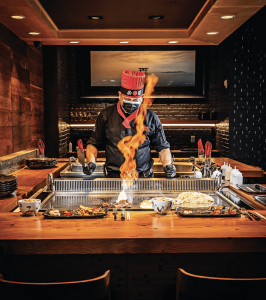An Inside Look at Azumi’s Flame Room Teppanyaki Tables
Jane Marion | Baltimore Magazine

Jane Marion | Baltimore Magazine
At the private Flame Room at Azumi in Harbor East, chefs work one of five teppanyaki tables, as customers gather ’round, six to a table, for dinner and a show at one of the hottest, and we mean that literally, tables in town.
With its photographs of Japan from famed photographer Peter Lik and dramatic mood lighting, this is not the Benihana steakhouse of yesteryear. Here, chefs crack the occasional corny joke, and dazzle with their surgically precise knife skills, as flames flare, but don’t expect to catch a flying shrimp in your mouth—this space has a more fine-dining pedigree, inspired by a 2018 trip Azumi owners Alex and Eric Smith took to Japan with several team members.
“We ate at four teppanyaki restaurants in Toyko and Kyoto and taste-tested our way through,” recalls Joe Sweeney, director of public relations for Atlas.
At The Flame Room, the focus is on preparing high-end ingredients—a two- and-a-half pound Maine lobster, rare Skull Island Australian shrimp, A5 Miyazaki beef sourced from Japan—across a “teppanyaki” grill, a practice believed to have started in Japan some 200 years ago when families gathered to cook dinner around a grill. (“Teppan” translates to iron plate, “yaki” means pan-fried or grilled.)
“Our chefs trained for years to work the teppanyaki table,” says Alisher Yallaev, Azumi’s culinary director of Asian cuisine. “We have three chefs with a combined experience of 50 years.” And that includes El Salvador-born chef German Canales, (pictured).
“People love it,” he says. “Their eyes are wide when they watch me cook—it’s a lot of pressure.”At the private Flame Room at Azumi in Harbor East, chefs work one of five teppanyaki tables, as customers gather ’round, six to a table, for dinner and a show at one of the hottest, and we mean that literally, tables in town.
With its photographs of Japan from famed photographer Peter Lik and dramatic mood lighting, this is not the Benihana steakhouse of yesteryear. Here, chefs crack the occasional corny joke, and dazzle with their surgically precise knife skills, as flames flare, but don’t expect to catch a flying shrimp in your mouth—this space has a more fine-dining pedigree, inspired by a 2018 trip Azumi owners Alex and Eric Smith took to Japan with several team members.
“We ate at four teppanyaki restaurants in Toyko and Kyoto and taste-tested our way through,” recalls Joe Sweeney, director of public relations for Atlas.
At The Flame Room, the focus is on preparing high-end ingredients—a two- and-a-half pound Maine lobster, rare Skull Island Australian shrimp, A5 Miyazaki beef sourced from Japan—across a “teppanyaki” grill, a practice believed to have started in Japan some 200 years ago when families gathered to cook dinner around a grill. (“Teppan” translates to iron plate, “yaki” means pan-fried or grilled.)
“Our chefs trained for years to work the teppanyaki table,” says Alisher Yallaev, Azumi’s culinary director of Asian cuisine. “We have three chefs with a combined experience of 50 years.” And that includes El Salvador-born chef German Canales, (pictured).
“People love it,” he says. “Their eyes are wide when they watch me cook—it’s a lot of pressure.”